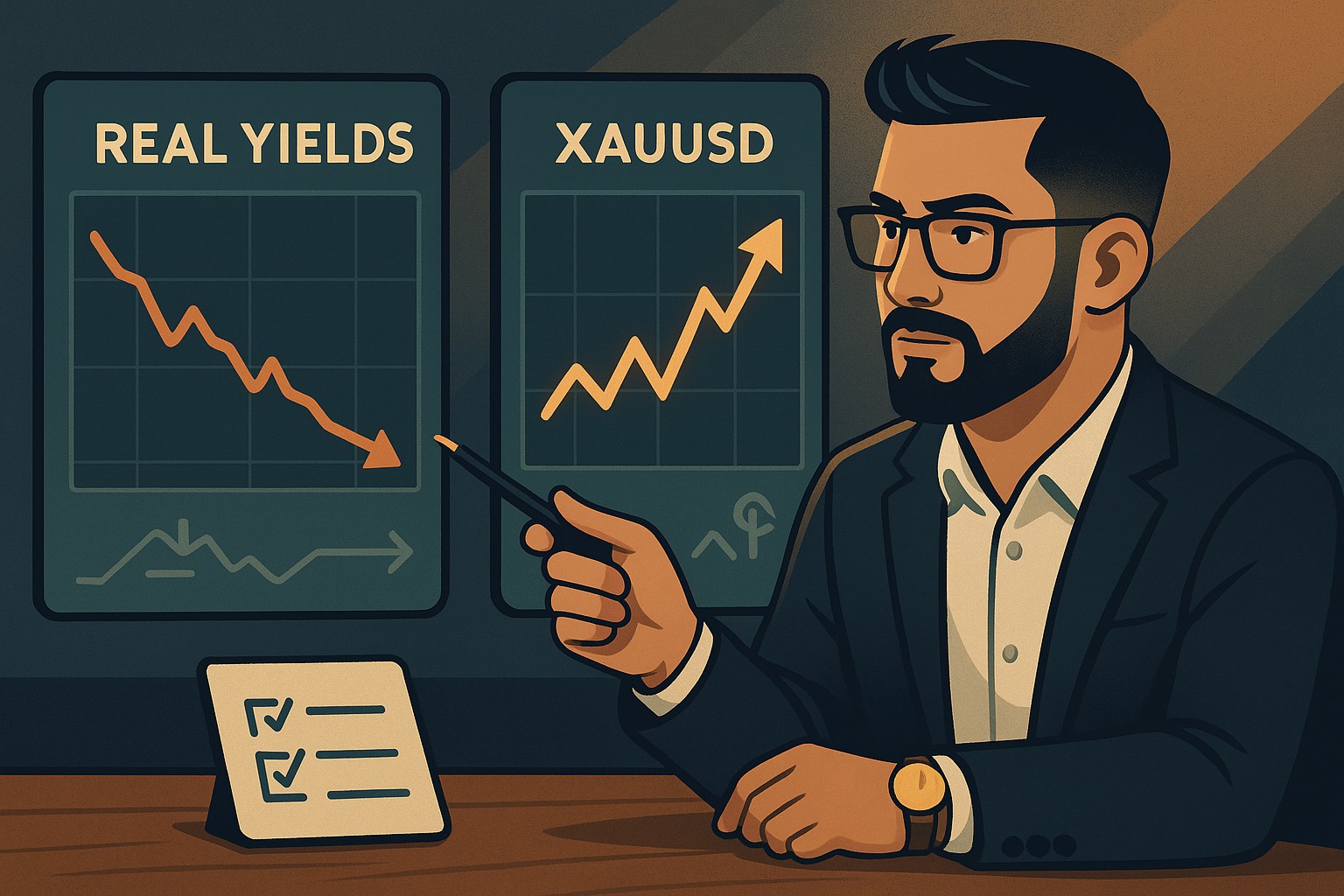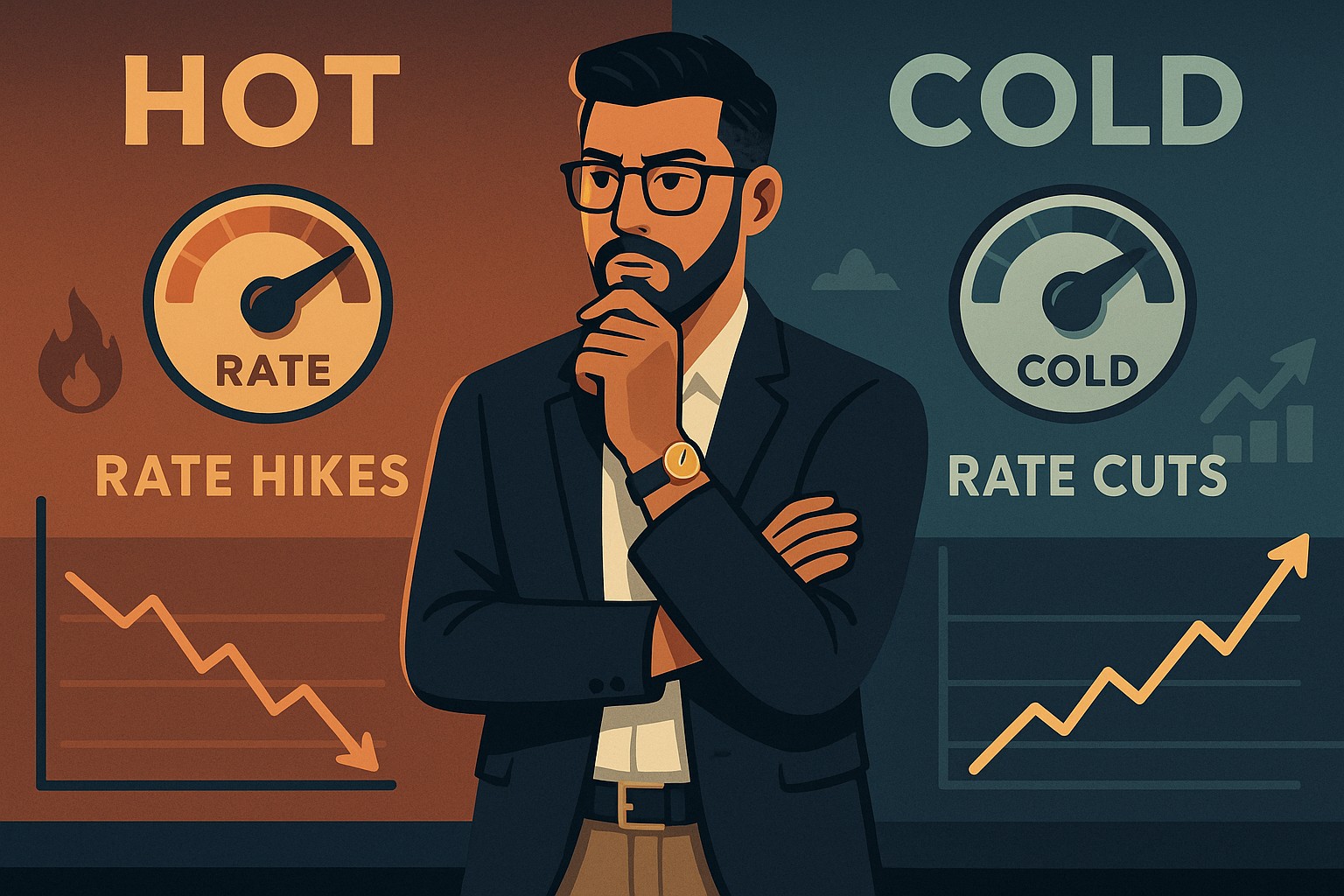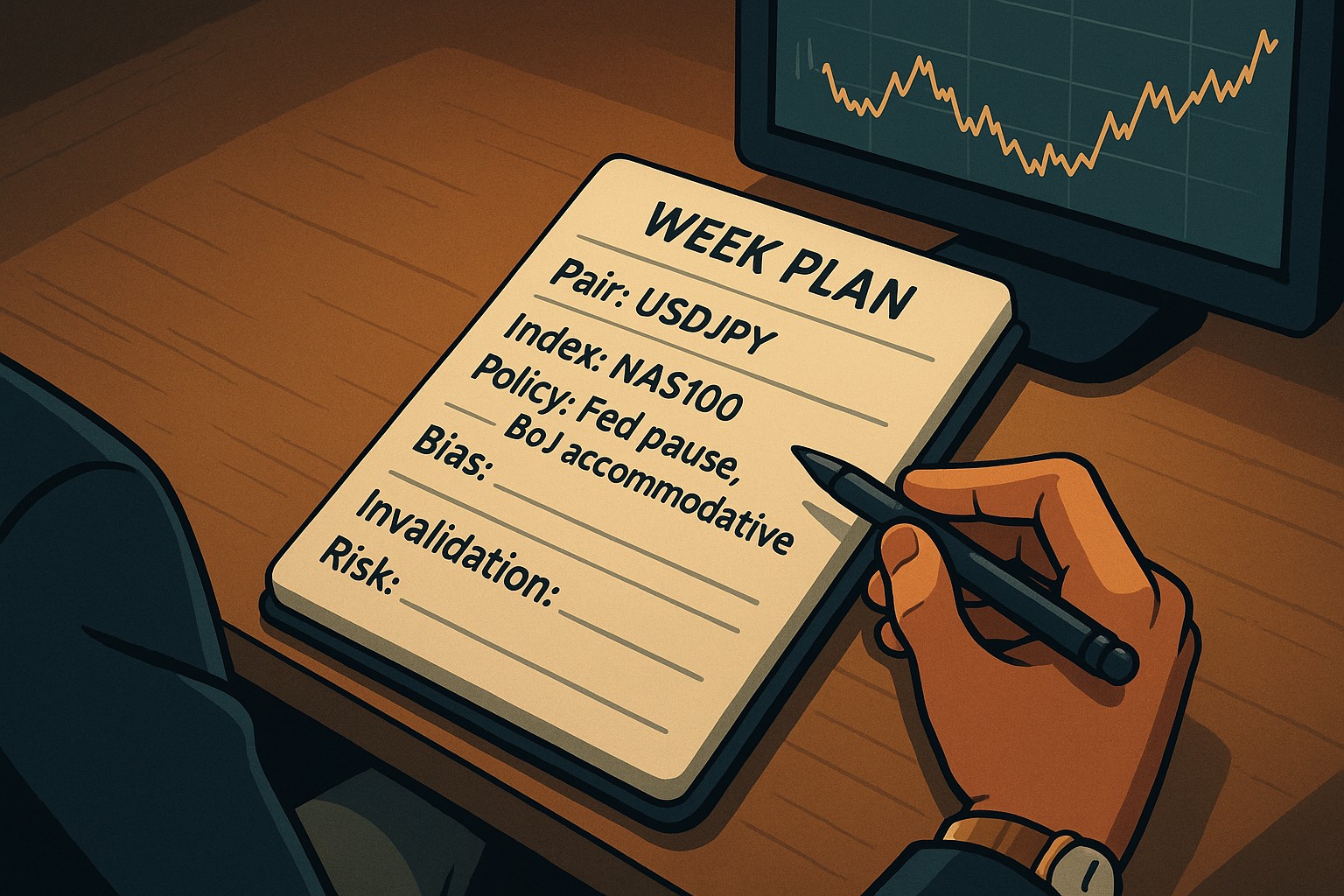Central Banks and Interest Rates: How They Move Your Trades
2025-09-29 13:09:05
If you’ve ever wondered why your chart gaps on open or why a clean setup suddenly dies, the answer usually isn’t a mysterious pattern. It is central banks. A handful of policymakers adjust one lever that flows into almost every trade you place: interest rates. When inflation runs hot, they hike to cool the economy. When growth stalls, they cut to warm it back up. Those decisions don’t just move a headline. They set the temperature of your trading environment: your currency pairs, your index plays, even your gold positions.

Before you chase another candle, step back and map the thermostat. In this first chapter of your Market Drivers Series, you will see how rate cycles shape price, why the tone of central bank communication matters as much as the decision, and which banks you need to watch every week.
Why Central Banks Move Your Market
Central banks are not background noise. They are the pulse you feel in price.
- They redirect global capital. If the Federal Reserve signals higher for longer, yield-seeking capital leans into USD assets. If the Bank of Japan stays ultra-easy, the yen often funds carry trades that spill into the pairs you watch.
- Their words reprice expectations. One sentence like “data dependent” or “policy sufficiently restrictive” can flip risk mood in minutes. If you want a quick primer on timing volatility around the bell, study how professional flows stack at the open using a structured approach like this guide on trading and scalping indices at the open. It shows you how liquidity and session dynamics amplify central bank narratives in the first hour.
- They set real yields, which set your backdrop. When policy tightens and real yields rise, non-yielders like gold face a headwind. When policy eases and real yields compress, gold’s bid strengthens. If you focus on XAU, keep this complete day-trading gold guide close. It walks through confirmations you can overlay on the macro story.
How Rate Hikes and Cuts Hit Your Positions
1. Your Currency Trades

Hikes usually boost the currency because yields attract capital. Long USD when the Fed tightens while others pause can ride a multi-week trend.
Cuts usually weigh on the currency as money looks elsewhere for yield. If you are long into a surprise cut, your stop might be the only friend you have left.
To avoid forcing trades into the wrong backdrop, build your plan around a small set of multi-timeframe checks. This power of multi-timeframe analysis primer is a practical way to keep the big picture from blindsiding your entries.
2. Your Index Plays

Hikes raise the cost of capital, pressure margins, and cool risk appetite. Rallies can still pop on “good news is good news,” but the path gets choppy.
Cuts lower financing costs and often revive risk appetite. That is why a dovish turn can ignite tech-heavy indices.
Trade plans that survive regime shifts share one thing: risk standards that do not bend. If you have not formalized yours, consolidate around this risk management compilation and lock your max risk per trade, daily loss limit, and weekly draw cap before you chase momentum.
3. Your Gold Positions

Hikes lift real yields and often sap gold’s appeal.
Cuts compress real yields and tend to fuel sustained XAU bids.
Gold is narrative driven, but execution still matters. For clean examples of confirmation, this how to exit and take profits in gold piece shows practical take-profit logic you can adapt when policy winds are at your back.
The Thermostat Analogy

Picture your house on a humid afternoon. You nudge the thermostat down to cool the room. That is a rate hike cooling an overheated economy. In a cold snap, you tap the heat up. That is a rate cut warming a stagnating economy. The catch is lag. Just like a thermostat overshoots before it stabilizes, policy works with delays and sometimes overshoots too. Those overshoots are the volatile swings that punish late entries and reward prepared plans.
If you catch yourself forcing trades during policy inflection weeks, step away and forward test on paper first. A short live rehearsal can save you real money. If you need a structure, use this forward testing guide to prove your rules while the macro regime settles.
The Central Banks You Must Track

You do not need to watch every bank, but these nine shape most of what you trade:
- Federal Reserve - United States (Fed). Dual mandate: price stability and maximum employment. The dollar is the global reserve currency, so Fed expectations spill into nearly all assets you touch.
- European Central Bank - Eurozone (ECB). Price stability for the euro area. Divergences inside Europe make guidance tricky and market sensitive.
- Bank of Japan (BoJ). Price and financial stability. Famous for ultra-easy policy and yield-curve control. Any hint of normalization has outsized effects on JPY and global carry.
- Bank of England (BoE). Inflation targeting with a growth lens. GBP responds sharply to BoE’s inflation language and labor data.
- Reserve Bank of Australia (RBA). Aims for currency stability, full employment, and prosperity. AUD tracks China’s cycle and commodities, so RBA plus China data is your combo.
- Reserve Bank of New Zealand (RBNZ). Early adopter of inflation targeting. NZD can be a clean proxy for shifts in risk and dairy-linked terms of trade.
- People’s Bank of China (PBoC). Focus on growth, financial stability, and currency management. Moves in liquidity and fixing levels quietly steer Asia and commodities.
- Bank of Canada (BoC). Inflation targeting with a resource economy twist. CAD often dances with oil, so policy plus crude makes your bias.
- Swiss National Bank (SNB). Price stability with a safe-haven halo. Surprise actions can shock CHF crosses. Respect their history and keep sizing humble.
Reading the Language Without Overreacting
A decision is the headline. Guidance is the substance. Learn to grade both:
- Decision vs expectation. A 25 bp hike when 25 was priced is less important than a new dot plot pointing higher for longer.
- Tone and triggers. Words like “elevated,” “restrictive,” or “data dependent” reset the path.
- Path, not point. Markets trade the likely path of policy, not a single meeting. You do not need to predict every step. You only need to know if the path is tightening, pausing, or easing.
If you struggle to keep your bias aligned, shrink size during policy weeks and let structure confirm. The goal is not to be first. It is to be positioned when the thermostat has clearly moved.
Final thoughts

If you take one idea forward, make it this: central banks set the temperature, you decide the layers. When policy tightens, you trade lighter, pick your spots, and demand stronger confirmation. When policy eases, you let winners breathe a little longer, but never drop your risk brakes. The thermostat is not under your control, but how you dress for the room is.
Try this for the week ahead: pick one pair and one index. Write down the current policy path for the relevant banks, your bias, the invalidation level, and the exact risk you will take. Trade only when your chart and the thermostat agree.
Start Practicing with Confidence - Risk-Free!
- Trade forex, indices, gold, and more
- Access ACY, MT4, MT5, & Copy Trading Platforms
- Practice with zero risk
It’s time to go from theory to execution - risk-free.
Create an Account. Start Your Free Demo!
Check Out My Contents:
Strategies That You Can Use
Looking for step-by-step approaches you can plug straight into the charts? Start here:
- How To Trade & Scalp Indices at the Open Using Smart Money Concepts (SMC)
- How to Trade Breakouts Effectively in Day Trading with Smart Money Concepts
- Complete Step-by-Step Guide to Day Trading Gold (XAU/USD) with Smart Money Concepts (SMC)
- The Power of Multi-Timeframe Analysis in Smart Money Concepts (SMC)
- Forex Trading Strategy for Beginners
- Mastering Candlestick Pattern Analysis with the SMC Strategy for Day Trading
- How to Use Fibonacci to Set Targets & Stops (Complete Guide)
- RSI Divergence Trading Strategy for Gold: How to Identify and Trade Trend Reversals
- Stochastics Trading Secrets: How to Time Entries in Trending Markets using Stochastics
- Gold Trading Stochastics Strategy: How to Trade Gold with 2R - 3R Targets
- RSI Hidden Divergence Explained: How to Spot Trend Continuations Like a Pro
- Moving Averages Trading Strategy Playbook
- Mastering Fibonacci Trading Psychology - Trusting the Levels, Managing the Mind
- Mastering Price Action at Key Levels - How to Spot, Trade, and Win at the Most Crucial Zones
- Mastering Retests: How to Enter with Confirmation After a Breakout
Indicators / Tools for Trading
Sharpen your edge with proven tools and frameworks:
- The Ultimate Guide to Risk Management in Trading - A Complete Compilation for 2025
- Moving Averages Trading Strategy Playbook
- How to Think Like a Price Action Trader
- Mastering Fibonacci Trading Psychology - Trusting the Levels, Managing the Mind
How To Trade News
News moves markets fast. Learn how to keep pace with SMC-based playbooks:
- Why Smart Money Concepts Work in News-Driven Markets - CPI, NFP, and More
- How to Trade NFP Using Smart Money Concepts (SMC)-A Proven Strategy for Forex Traders
- How to Trade CPI Like Smart Money - A Step-by-Step Guide Using SMC
Learn How to Trade US Indices
From NASDAQ opens to DAX trends, here’s how to approach indices like a pro:
- How to Start Trading Indices and Get into the Stock Market with Low Capital (2025 Guide)
- Best Indices to Trade for Day Traders | NASDAQ, S&P 500, DAX + Best Times to Trade Them
- How To Trade & Scalp Indices at the Open Using Smart Money Concepts (SMC)
- NAS100 - How to Trade the Nasdaq Like a Pro (Smart Money Edition)
How to Start Trading Gold
Gold remains one of the most traded assets - - here’s how to approach it with confidence:
- How to Swing Trade Gold (XAU/USD) Using Smart Money Concepts: A Simple Guide for Traders
- Complete Step-by-Step Guide to Day Trading Gold (XAU/USD) with Smart Money Concepts (SMC)
- The Ultimate Guide to Backtesting and Trading Gold (XAU/USD) Using Smart Money Concepts (SMC)
- Why Gold Remains the Ultimate Security in a Shifting World
- How to Exit & Take Profits in Trading Gold Like a Pro: Using RSI, Range Breakdowns, and MAs as Your Confluence
How to Trade Japanese Candlesticks
Candlesticks are the building blocks of price action. Master the most powerful ones:
- Mastering the Top Japanese Candlesticks: The Top 5 Candlesticks To Trade + Top SMC Candlestick Pattern
- How to Trade Candlestick Patterns with High Probability: A Complete Guide for Beginners
- The Top Japanese Candlestick Guide: What is an Engulfing Pattern and How to Trade It?
- Piercing Pattern Candlestick Explained: How to Trade It - Step-By-Step Guide
- Morning & Evening Star Candlestick Patterns - How to Trade Market Reversals with Confidence
How to Start Day Trading
Ready to go intraday? Here’s how to build consistency step by step:
- 5 Steps to Start Day Trading: A Strategic Guide for Beginners
- 8 Steps How to Start Forex Day Trading in 2025: A Beginner’s Step-by-Step Guide
- 3 Steps to Build a Trading Routine for Consistency and Discipline - Day Trading Edition
- The Ultimate Guide to Understanding Market Trends and Price Action
- Trading with Momentum: The Best Trading Session to Trade Forex, Gold and Indices
Learn how to navigate yourself in times of turmoil
Markets swing between calm and chaos. Learn to read risk-on vs risk-off like a pro:
- How to Identify Risk-On and Risk-Off Market Sentiment: A Complete Trader’s Guide
- How to Trade Risk-On and Risk-Off Sentiment - With Technical Confirmation
- The Ultimate Guide to Understanding Market Trends and Price Action
Want to learn how to trade like the Smart Money?
Step inside the playbook of institutional traders with SMC concepts explained:
- Why Smart Money Concepts Work: The Truth Behind Liquidity and Price Action
- Mastering the Market with Smart Money Concepts: 5 Strategic Approaches
- Understanding Liquidity Sweep: How Smart Money Trades Liquidity Zones in Forex, Gold, US Indices
- The SMC Playbook Series Part 1: What Moves the Markets? Key Drivers Behind Forex, Gold & Stock Indices
- The SMC Playbook Series Part 2: How to Spot Liquidity Pools in Trading-Internal vs External Liquidity Explained
- Fair Value Gaps Explained: How Smart Money Leaves Footprints in the Market
- Accumulation, Manipulation, Distribution: The Hidden Cycle That Runs Every Market
- Institutional Order Flow - Reading the Market Through the Eyes of the Big Players
- London Session Trading Secrets: How Smart Money Sets the High & Low of the Day
- Mastering the New York Session - Smart Money Concepts Guide
Master the World’s Most Popular Forex Pairs
Forex pairs aren’t created equal - - some are stable, some are volatile, others tied to commodities or sessions.
- The Top 5 All-Time Best Forex Pairs to Trade
- Top Forex Pairs Beyond the Big Five
- EUR/USD: The King of Forex
- USD/JPY: The Fast Mover
- GBP/USD: The Volatile Cable
- AUD/USD: The Commodity Currency
- USD/CAD: The Oil-Backed Pair
- GBP/JPY: How to Trade The Beast
- Asian & London Session Secrets
- Mastering the New York Session
Stop Hunting 101
If you’ve ever been stopped out right before the market reverses - - this is why:
- Stop Hunting 101: How Swing Highs and Lows Become Liquidity Traps
- Outsmarting Stop Hunts: The Psychology Behind the Trap
- How to Lessen Risk From Stop Hunts in Trading
- How Stop Hunts Trigger Revenge Trading - Breaking the Pain Cycle
- How to Accept Stop Hunts Without Losing Discipline - Shifting From Frustration to Focus
Trading Psychology
Mindset is the deciding factor between growth and blowups. Explore these essentials:
- The Mental Game of Execution - Debunking the Common Trading Psychology
- Managing Trading Losses: Why You Can Be Wrong and Still Win Big in Trading
- The Hidden Threat in Trading: How Performance Anxiety Sabotages Your Edge
- Why 90% of Retail Traders Fail Even with Profitable Trading Strategies
- Top 10 Habits Profitable Traders Follow Daily to Stay Consistent
- Top 10 Trading Rules of the Most Successful Traders
- Top 10 Ways to Prevent Emotional Trading and Stay Disciplined in the Markets
- Why Most Traders Fail - Trading Psychology & The Hidden Mental Game
- Emotional Awareness in Trading - Naming Your Triggers
- Discipline vs. Impulse in Trading - Step-by Step Guide How to Build Control
- Trading Journal & Reflection - The Trader’s Mirror
- Overcoming FOMO & Revenge Trading in Forex - Why Patience Pays
- Risk of Ruin in Trading - Respect the Math of Survival
- Identity-Based Trading: Become Your Trading System for Consistency
- Trading Psychology: Aligning Emotions with Your System
- Mastering Fear in Trading: Turn Doubt into a Protective Signal
- Mastering Greed in Trading: Turn Ambition into Controlled Growth
- Mastering Boredom in Trading: From Restless Clicking to Patient Precision
- Mastering Doubt in Trading: Building Confidence Through Backtesting and Pattern Recognition
- Mastering Impatience in Trading: Turn Patience Into Profit
- Mastering Frustration in Trading: Turning Losses Into Lessons
- Mastering Hope in Trading: Replacing Denial With Discipline
- When to Quit on Trading - Read This!
- The Math of Compounding in Trading
- Why Daily Wins Matter More Than Big Wins
- Scaling in Trading: When & How to Increase Lot Sizes
- Why Patience in Trading Fuels the Compounding Growth
- Step-by-Step Guide on How to Manage Losses for Compounding Growth
- The Daily Habits of Profitable Traders: Building Your Compounding Routine
- Trading Edge: Definition, Misconceptions & Casino Analogy
- Finding Your Edge: From Chaos to Clarity
- Proving Your Edge: Backtesting Without Bias
- Forward Testing in Trading: How to Prove Your Edge Live
- Measuring Your Edge: Metrics That Matter
- Refining Your Edge: Iteration Without Overfitting
- The EDGE Framework: Knowing When and How to Evolve as a Trader
- Scaling Your Edge: From Small Account to Consistency
Risk Management
The real edge in trading isn’t strategy - it’s how you protect your capital:
- Mastering Risk Management: Stop Loss, Take Profit, and Position Sizing
- Why Risk Management Is the Only Edge That Lasts
- How Much Should You Risk per Trade? (1%, 2%, or Less?)
- The Ultimate Risk Management Plan for Prop Firm Traders - Updated 2025
- Mastering Position Sizing: Automate or Calculate Your Risk Like a Pro
- Martingale Strategy in Trading: Compounding Power or Double-Edged Sword?
- How to Add to Winners Using Cost Averaging and Martingale Principle with Price Confirmation
Suggested Learning Path
If you’re not sure where to start, follow this roadmap:
- Start with Trading Psychology → Build the mindset first.
- Move into Risk Management → Learn how to protect capital.
- Explore Strategies & Tools → Candlesticks, Fibonacci, MAs, Indicators.
- Apply to Assets → Gold, Indices, Forex sessions.
- Advance to Smart Money Concepts (SMC) → Learn how institutions trade.
- Specialize → Stop Hunts, News Trading, Turmoil Navigation.
This way, you’ll grow from foundation → application → mastery, instead of jumping around randomly.
Follow me for more daily market insights!
Jasper Osita - LinkedIn - FXStreet - YouTube
This content may have been written by a third party. ACY makes no representation or warranty and assumes no liability as to the accuracy or completeness of the information provided, nor any loss arising from any investment based on a recommendation, forecast or other information supplies by any third-party. This content is information only, and does not constitute financial, investment or other advice on which you can rely.
Try These Next
4 Powerful Tactics to Overcome the Most Costly Forex Mistakes
How to Master MT4 & MT5 - Tips and Tricks for Traders
The Importance of Fundamental Analysis in Forex Trading
Forex Leverage Explained: Mastering Forex Leverage in Trading & Controlling Margin
The Importance of Liquidity in Forex: A Beginner's Guide
Close All Metatrader Script: Maximise Your Trading Efficiency and Reduce Stress
Best Currency Pairs To Trade in 2025
Forex Trading Hours: Finding the Best Times to Trade FX
MetaTrader Expert Advisor - The Benefits of Algorithmic Trading and Forex EAs
Top 5 Candlestick Trading Formations Every Trader Must Know















